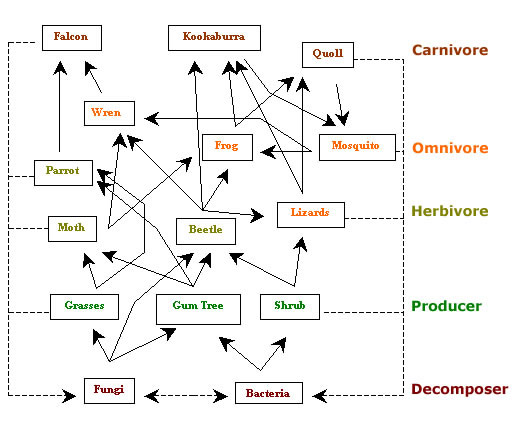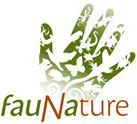Many different elements contribute to a successful wildlife garden. While the major aspects have been covered in earlier blogs, additional information is provided here which will further enhance the environment you provide.
Benefits of Diversity
Every animal requires food. The benefits of complexity in nature and in your garden quickly becomes evident when we look at a simplified food web (Fig. 1). Plants form the basis of the food webs you are looking to establish. The greater the number and type of plant species you nurture, the higher the diversity of animals you are likely to see. The more complex your garden, fewer pest species will have an impact and the more stable will be the environment. Stability and resources result in a healthy, attractive wildlife garden. Therefore, the more birds and animals, both in type and number, you are likely to attract.

Fig 1. A simplified food web to demonstrate just how complex species interactions can be.
Avoid Chemicals
Reduce or eliminate the uses of herbicides and pesticides. Using chemicals in the garden on either plants or animals (e.g. snails or insects) not only affects the species you want to remove, but can also impact other, non-target species. Therefore, by using chemicals, both plant and animal species may be eliminated – reducing the available food or potentially accumulating in the food chain to poison the very wildlife species you are looking to attract.
Household Pets
Pets, particularly cats, can have a profound impact on wildlife, from beetles to butterflies and bluetongue lizards to gliders. The cat owner may be distressed by an occasional or even regular supply of “presents”. Cats are also renowned for unwanted intrusions into neighbouring properties, fouling yards, digging up the gardens as well as preying on wildlife.
It is preferable if cats are permanently kept inside with access to the garden facilitated via a cat run. Where cats are allowed to roam it is recommended that cats remain inside at night, from dusk till dawn – this period is when native species are most vulnerable and cats most destructive.
Additionally, the owners of roaming cats are encouraged to attach an elasticised collar with bells on it (often one bell will not do the trick and two or three will be required to prevent the cat from silent stalking).
Surveys have shown that the average domestic cat will make over 50 kills a year, with some particularly effective individuals achieving over ten times this number. In addition to pet cats, many feral animals exist which have a devastating impact on local wildlife. If you are a gardening/wildlife enthusiast looking to avoid unwanted intrusions or a cat owner who would like your cat to avoid certain areas in your own yard (e.g. a bird bath) – ultrasonic deterrents (e.g. CATWatch) may offer a solution. For information on CATWatch refer to our on-line shop.
Dogs generally have far less impact on native wildlife. However, lizards, particularly large slow-moving species such as bluetongues, can be very susceptible to dog attacks. Rock piles, hollow logs (or partially buried pipes) and dense, spiky ground plants, provide beneficial cover and shelter. Training your dog to listen and act on your commands is paramount so they leave wildlife alone. Whether your dog is a home body or loves long walks, appropriate training could reduce your stress and save the life(s) of your resident bluetongues, possums, ground-nesting birds at the beach (e.g., Hooded Plovers) as well as kangaroos if you live in or visit more rural locations.
There is a limited amount of literature available on attracting wildlife to backyards. Fortunately, the quality and quantity are on the increase, making it easier for each of us to make informed decisions about enhancing our Wildlife Gardens.
